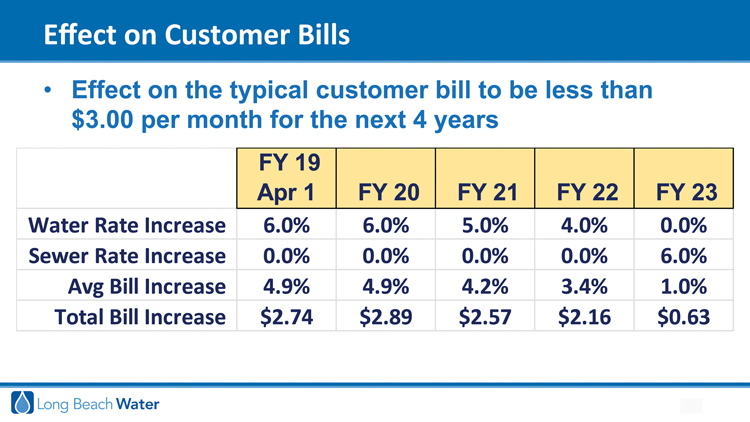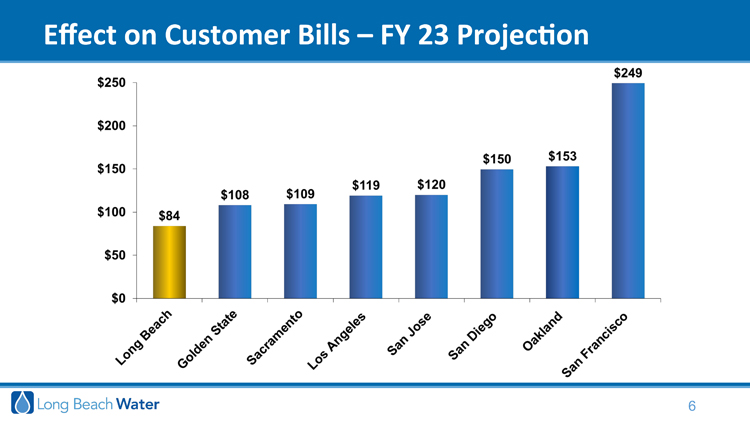When then-Gov. Jerry Brown lifted the drought emergency in April 2017, many Californians let out a sigh of relief. For municipal utilities like the Long Beach Water Department, the news came as an opportunity to prepare for a dry future ahead. Department staff are projecting a series of water rate increases over the next four years to pay for improvements in infrastructure aimed at increasing local water production and system efficiency.
In total, the projected increases would add about $10 to the average household’s monthly bill by 2023, according to the water department. The Long Beach Board of Water Commissioners is holding a public hearing on March 7 to discuss a proposed mid-year rate increase of 6%, which would go into effect on April 1. Following the hearing, the proposal will be sent to the city council for approval. The department is seeking to increase rates another 6% in October 2019, 5% in 2020 and 4% in 2021, which will have to pass the same approval process.
The agency last increased rates in October 2018, when a 7.2% rate increase was implemented following voters’ approval of Measure M. The ballot initiative increased the agency’s contributions to the General Fund. Prior to this action, the city had temporarily decreased rates by 4.2% as a result of a legal battle in which plaintiffs alleged that the city had overcharged Long Beach Water for pipeline transfer fees to pad its General Fund. The resulting settlement required the city to decrease pipeline fees and pay a $12 million refund from the city’s General Fund to the Water Fund. Prior to the rate fluctuations of 2018, the agency had increased rates by 4% each year since October 2013, according to annual budget summaries.


While sewer rates increased by about 2% to 4% each year since 2013, the agency did not increase sewer rates as part of its budgeting process for Fiscal Year 2019. There is no increase in sewer rates planned as part of the proposed water rate hike.
Part of the funds raised by the increase will go towards bond payments for a $28 million effort to automate all water meters across the Long Beach Water Department’s system, a project the agency hopes will improve efficiency and decrease labor costs currently spent on manual metering. In total, the increase is expected to bring in $2.7 million in additional revenue by the end of the fiscal year on September 30, 2019, according to Long Beach Water General Manager Chris Garner. The agency’s budget summary for the current fiscal year released in late 2018, shows an expected increase in expenditures of $14.8 million.
Despite the increases, Garner said his agency’s rates were still highly competitive. “If you compare our rates for water and sewer delivery versus the other major cities in California, we’re much, much lower than every other large city,” Garner pointed out. The projected bill for the average Long Beach customer, including county fees and projected rate increases, will come out to approximately $84 after adjustment for inflation, according to a staff presentation to the agency’s board. For comparison, the average household in Los Angeles will pay around $119 for sewage, water and fees each month in 2023 and the average household in San Francisco will pay $249 per month, according to projections included in the same presentation.
“What you’re seeing statewide is that water is a limited resource, and the state is trying to catch up from the drought, so everybody’s investing into storage and new pumping and trying to make sure we’re better prepared for the next drought,” Garner explained.
Long Beach Water is taking a two-pronged approach in its efforts to ensure sustainable and cost-effective water sourcing for its clients. Over the past few years, the agency has replaced outdated, cast-iron pipes underneath some of the city’s oldest neighborhoods in downtown and central Long Beach. By replacing the cast-iron pipes, Garner said the average number of main breaks has been reduced from around 200 per year in the early 2000s to a current average of less than 30 main breaks per year.
Now, the agency is looking to improve the productivity of the local well system and add more storage tanks to hold the precious resource. “As our wells become less productive, we have to buy water from the Metropolitan Water District, and that’s the most expensive water,” Greg Sorensen, the agency’s manager of budget and rates, explained. “Wells are expensive, but you have to do it, otherwise we’re just going to fall more and more behind.”
